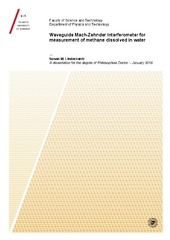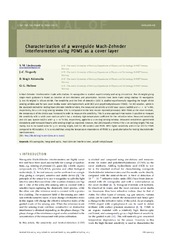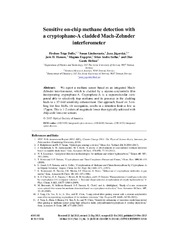| dc.contributor.advisor | Hellesø, Olav Gaute | |
| dc.contributor.author | Lindecrantz, Susan M. | |
| dc.date.accessioned | 2016-05-24T09:56:17Z | |
| dc.date.available | 2016-05-24T09:56:17Z | |
| dc.date.issued | 2016-04-25 | |
| dc.description.abstract | In this dissertation, we present the development of a novel, compact and highly sensitive waveguide Mach-Zehnder interferometer to measure methane dissolved in water. Methane is a greenhouse gas, like carbon dioxide, and is emitted from both natural sources and human activities. Due to the challenges to measure dissolved methane in the sea and the vast area it covers, much of the methane cycle is unknown. In the last couple of years, there has been an up-swing in the development of subsea methane sensors. These high-end sensors rely on successfully separating the dissolved gas from the water with a membrane before the measurements, effecting the limit of detection, response time and it may give rise to hysteresis effects. Alternatively, samples can be transported to an on-shore laboratory, which can be time-consuming and expensive.
We developed a methane sensor with the possibilities of direct and in-situ detection of methane with a relatively cheap and compact optical sensor-chip. A methane sensitive layer, consisting of a host-polymer and cryptophane-A, is deposited onto the chip. Cryptophane-A is a supra-molecular compound that can entrap methane molecules within its structure and thus, induce a change in the refractive index of the host-polymer. This change is detected by the evanescent field from the waveguide, in the sensing arm of the interferometer. Thus, with a change in refractive index in the sensitive layer, a phase change between the reference and the sensing arms of the interferometer is obtained.
For obtaining optimal design, simulations were made for shallow silicon nitride rib waveguides with respect to the sensitivity as function of refractive index and the mode-behaviour of the waveguide. Once the design had been established, the waveguides were fabricated externally, with a core thickness of 150 nm, a rib height of 5 nm, rib widths of 1.5, 2 and 3 μm and sensing lengths of 1, 2 and 3 cm. The propagation losses were measured and simulated for tantalum pentoxide (similar to silicon nitride) strip and rib waveguides, to find the dependence of the propagation losses on the waveguide width. The sensitivity of the sensor was characterised with a diluted acid (HCl) and, in a separate measurement, by changing the temperature of the sensor coated with a polymer (PDMS).
The sensor was combined with a methane sensitive layer of styrene acrylonitrile (SAN) and cryptophane-A, to detect methane gas. The sensitive layer showed a 17-folded sensitivity increase with a cryptophane-A to SAN ratio of 1:9. Methane gas was measured in the range of 300 ppm to 4.4%(v/v), with a detection limit of 17 ppm. Finally, the sensor was tested with methane in water. It was found that when the sensitive layer was exposed to water, the SAN polymer showed fractures along the surface. In an effort to circumvent the problem, a protecting layer of PDMS was deposited directly onto the SAN layer. However, after some time bubble structures appeared within the layer after exposure to water. Despite this, dissolved methane was successfully and repeatedly detected for concentration in range 9 to 46 μM. A detection limit of 49 nM was obtained, showing that the sensor is suitable for measurements of methane dissolved in water. | en_US |
| dc.description.doctoraltype | ph.d. | en_US |
| dc.description.popularabstract | Ein optisk sensor for måling av metankonsentrasjonen i luft og i vatn har blitt utvikla. Metan er ein drivhusgass og det er viktig å overvaka utslepp både frå menneskeskapte og frå naturlege kjelder som tundra, våtmark og havet. Til dette er det nødvendig med ein rimeleg, liten, sensitiv og presis sensor, noko den utvikla sensoren har potensial til å bli. Sensoren er basert på eit optisk interferometer laga med optiske bølgjeleiarar på ein brikke. Overflata av brikken vart dekka med eit sensitivt lag som fangar metan-molekyl. Dette gir ei endring i brytningsindeks, som det optiske interferometeret detekterer. Sensoren er testa i laboratoriet og gir relativt stor sensitivitet (17 ppm for gass og 49 nM i vatn). Dette er samanliknbart med sensitiviteten til avanserte metansensorar og vesentleg betre enn kva ein kan oppnå med enkle og rimelege sensorar. Undervegs i arbeidet har dei optiske eigenskapane til sensoren blitt studert, det vart laga design for sensorbrikken og sjølve brikken vart produsert i Barcelona. | en_US |
| dc.description.sponsorship | The project is funded by the Research Council of Norway as part of Research Initiative for Northern Norway (Nordsatsing). | en_US |
| dc.identifier.isbn | 978-82-8236-212-2 (trykt) og 978-82-8236-213-9 (pdf) | |
| dc.identifier.uri | https://hdl.handle.net/10037/9236 | |
| dc.identifier.urn | URN:NBN:no-uit_munin_8794 | |
| dc.language.iso | eng | en_US |
| dc.publisher | UiT Norges arktiske universitet | en_US |
| dc.publisher | UiT The Arctic University of Norway | en_US |
| dc.rights.accessRights | openAccess | |
| dc.rights.holder | Copyright 2016 The Author(s) | |
| dc.rights.uri | https://creativecommons.org/licenses/by-nc-sa/3.0 | en_US |
| dc.rights | Attribution-NonCommercial-ShareAlike 3.0 Unported (CC BY-NC-SA 3.0) | en_US |
| dc.subject | Mach-Zehner interferometer | en_US |
| dc.subject | Methane | en_US |
| dc.subject | Sensor | en_US |
| dc.subject | Cryptophane-A | en_US |
| dc.subject | Evanescent field | en_US |
| dc.subject | Optical waveguide | en_US |
| dc.title | Waveguide Mach-Zehnder interferometer for measurement of methane dissolved in water | en_US |
| dc.type | Doctoral thesis | en_US |
| dc.type | Doktorgradsavhandling | en_US |


 English
English norsk
norsk



